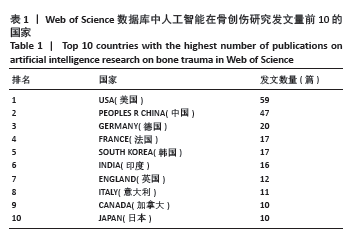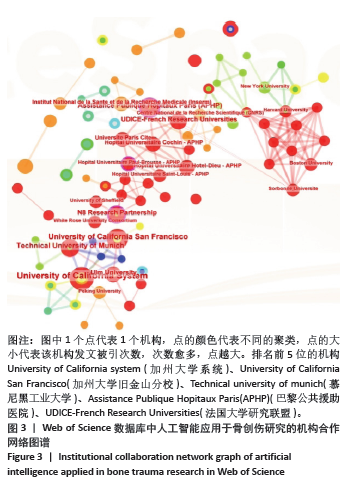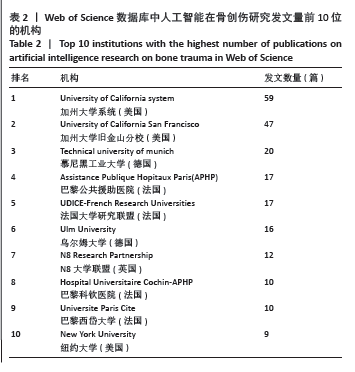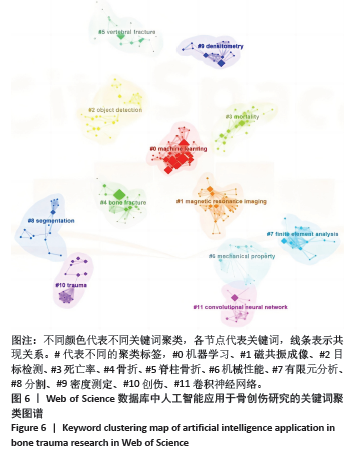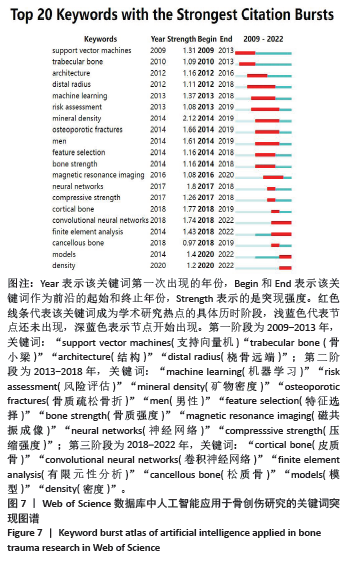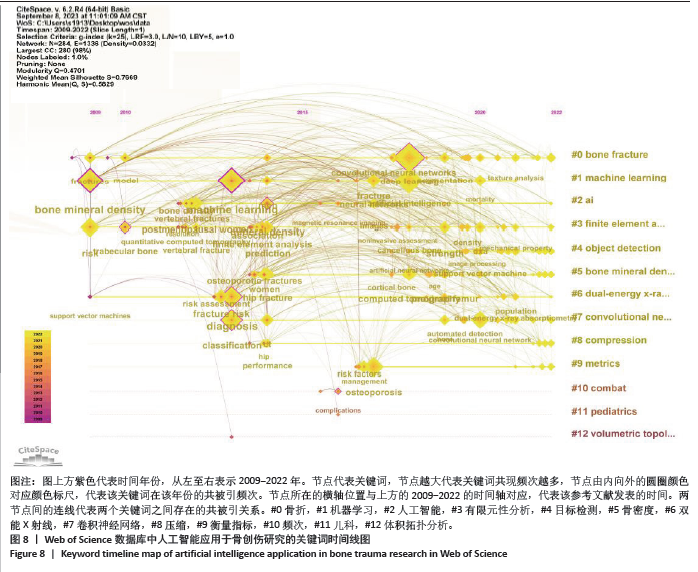[1] 薛冬,徐海林,王伟.人工智能辅助X射线识别对骨科的应用价值研究进展[J].中国骨伤,2020,33(9):887-890.
[2] 张建,谢会群,提克扎提,等.人工智能在骨科影像学诊断中的应用研究进展[J].中国数字医学,2023,18(4):95-103.
[3] SHAH AA, DEVANA SK, LEE C, et al. Development of a novel, potentially universal machine learning algorithm for prediction of complications after total hip arthroplasty. J Arthroplasty. 2020;36(5):1655-1662.
[4] 翟禹樵,李开南.骨科人工智能诊断的研究进展[J].中国临床研究, 021,34(4):542-545.
[5] LU Y, KHAZI ZM, AGARWALLA A, et al. Development of a machine learning algorithm to predict nonroutine discharge following unicompartmental knee arthroplasty. J Arthroplast. 2021;36(5): 1568-1576.
[6] DANKELMAN LHM, SCHILSTRA S, IJPMA FFA, et al. Artificial intelligence fracture recognition on computed tomography: review of literature and recommendations. Eur J Trauma Emerg Surg. 2022;49(2):681-691.
[7] KIJOWSKI R, LIU F, CALIVA F, et al. Deep learning for lesion detection, progression, and prediction of musculoskeletal disease. J Magn Reson Imaging. 2019;52(6):1607-1619.
[8] KUO RYL, HARRISON C, CURRAN T, et al. Artificial intelligence in fracture detection: a systematic review and meta-analysis. J Radiology. 2022;304(1):211785-211785.
[9] GUERMAZI A, TANNOURY C, KOMPEL AJ, et al. Improving radiographic fracture recognition performance and efficiency using artificial intelligence. J Radiology. 2021;302(3):210937-210937.
[10] AlGHAITHI A, Al MASKARI S. Artificial intelligence application in bone fracture detection. J Musculoskelet Surg Res. 2021;5(1):4-9.
[11] DEEPA J, THIPENDRA P, SINGH. A survey of fracture detection techniques in bone x-ray images. J Artif Intell Rev. 2020;(prepublish): 1-43.
[12] 陈悦,陈超美,刘则渊,等.Citespace知识图谱的方法论功能[J].科学学研究,2015,33(2):242-253.
[13] SYNNESTVEDT MB, CHEN C, HOLMES JH. Citespace ii: visualization and knowledge discovery in bibliographic databases. J AMIA Annu Symp Proc. 2005;2005:724-728.
[14] CHEN CM, SONG M. Visualizing a field of research: a methodology of systematic scientometric reviews. PLoS One. 2019;14(10):0223994.
[15] 任欢,曾奕玮,张粟,等.基于VOSviewer和Citespace分析功能性磁共振成像技术在针灸脑成像研究中的应用现状和趋势[J].世界科学技术-中医药现代化,2022,24(5):2114-2124.
[16] 应倩,汪媛.医学类期刊H指数与影响因子、总被引频次的曲线拟合回归分析[J].中华医学图书情报志,2011,20(11):23-26.
[17] 李科科,于文兵,李硕奇,等.基于Citespace软件的大学生社交焦虑研究的热点与前沿趋势分析[J].中国全科医学,2022,25(33): 4217-4226.
[18] 陈冉,杨皓然,史会连,等.1991-2021年肝硬化营养研究热点及趋势可视化分析[J].中国全科医学,2022,25(32):4091-4098.
[19] 郝文雪,李瑞青,胡延超,等.2010-2019年卒中后认知障碍相关研究的可视化分析[J].中国全科医学,2021,24(6):759-776.
[20] 李秋江,房晓敏,王胤斌,等.干细胞治疗椎间盘退变研究现状和趋势的文献计量学分析[J].中国组织工程研究,2021,25(31):5000-5011.
[21] VANDENPUT L, JOHANSSON H, MCClOSKEY EV, et al. Update of the fracture risk prediction tool FRAX: a systematic review of potential cohorts and analysis plan. J Osteoporosis Int. 2022;33(10):2103-2136.
[22] CABITZA F, LOCORO A, BANFI G. Machine learning in orthopedics: a literature review. Front Bioeng Biotechnol. 2018;6:75.
[23] LINDSEY R, DALUISKI A, CHOPRA S, et al. Deep neural network improves fracture detection by clinicians. J Proc Natl Acad Sci U S A. 2018;115(45):11591-11596.
[24] KIM DH, MACKINNON T. Artificial intelligence in fracture detection: transfer learning from deep convolutional neural networks. J Clin Radiol. 2018;73(5):439-445.
[25] CHUNG SW, HAN SS, LEE JW, et al. Automated detection and classification of the proximal humerus fracture by using deep learning algorithm. J Acta Orthop. 2018;89(4):1-6.
[26] OLCZAK J, FAHLBERG N, MAKI A, et al. Artificial intelligence for analyzing orthopedic trauma radiographs. J Acta Orthop. 2017;88(6):581-586.
[27] TOMITA N, CHEUNG YY, HASSANPOUR S, et al. Deep neural networks for automatic detection of osteoporotic vertebral fractures on CT scans. J Comput Biol Med. 2018;98:8-15.
[28] URAKAWA T, TANAKA Y, GOTO S, et al. Detecting intertrochanteric hip fractures with orthopedist-level accuracy using a deep convolutional neural network. J Skeletal Radiol. 2018;48(2):239-244.
[29] CHENG CT, HO TY, LEE TY, et al. Application of a deep learning algorithm for detection and visualization of hip fractures on plain pelvic radiographs. J Eur Radiol. 2019;29(10):5469-5477.
[30] PRANATA YD, WANG KC, WANG JC, et al. Deep learning and SURF for automated classification and detection of calcaneus fractures in CT images. Comput Methods Programs Biomed. 2019;171:27-37.
[31] BADGELEY MA, ZECH JR, OAKDEN-RAYNER L, et al. Deep learning predicts hip fracture using confounding patient and healthcare variables. NPJ Digit Med. 2019:2:31.
[32] ESTEVA A, KUPREL B, NOVOA RA, et al. Dermatologist-level classification of skin cancer with deep neural networks. J Nature. 2017; 542(7639):115-118.
[33] 毛昭冲,李福伟,杨凤云,等.有限元分析在桡骨远端骨折研究中的应用进展[J].中医正骨,2023,35(2):30-32, 45.
[34] 魏焕焕,杨燕,付芳芳,等.基于多模态MRI影像组学与深度学习的脑胶质瘤诊断及预后预测研究进展[J].磁共振成像,2023,14(5): 175-180.
[35] 李军,叶欣怡,杨长才,等.基于联合深度网络和形态结构约束的三维医学图像分割方法[J].中国生物医学工程学报,2023,42(1): 30-40.
[36] 邓佳丽,龚海刚,刘明.基于目标检测的医学影像分割算法[J].电子科技大学学报,2023,52(2):254-262.
[37] 刘良斌,杜宝林,卢琰,等.国内外图像分割技术在医疗健康领域应用发展态势分析[J].现代信息科技,2023,7(13):105-111.
[38] OZKAYA E, TOPAL FE, BULUT T, et al. Evaluation of an artificial intelligence system for diagnosing scaphoid fracture on direct radiography. J Eur J Trauma Emerg Surg. 2020;48(1):1-8.
[39] ÜRETEN K, SEVINÇ HF, İĞDELI U, et al. Use of deep learning methods for hand fractures detection from plain hand radiographs. J Ulus Travma Acil Cer. 2020;28(2):196-201.
[40] TUNG YC, SU JH, LIAO YW, et al. High-performance scaphoid fracture recognition via effectiveness assessment of artificial neural networks. J Applied Sciences. 2021;11(18):8485.
[41] HUHTANEN JT, NYMAN M, DONCENCO D, et al. Deep learning accurately classifies elbow joint effusion in adult and pediatric radiographs. J Sci. Rep. 2022;12(1):11803-11803.
[42] DREIZIN D, GOLDMANN F, LEBEDIS C, et al. An automated deep learning method for tile ao/ota pelvic fracture severity grading from trauma whole-body CT. J Digit Imaging. 2021;34(1):53-65.
[43] SATO Y, TAKEGAMI Y, ASAMOTO T, et al. Artificial intelligence improves the accuracy of residents in the diagnosis of hip fractures: a multicenter study. J BMC Musculoskel Dis. 2021;22(1):407-407.
[44] KIM J, MO Y, CHOI S, et al. Detecting ankle fractures in plain radiographs using deep learning with accurately labeled datasets aided by computed tomography: a retrospective observational study. J Appl Sci. 2021;11(19):8791-8791.
[45] 刘春,蹇文渊,段俊国.人工智能应用于糖尿病视网膜病变的文献计量学分析[J].中国全科医学,2023,26(15):1847-1856.
[46] 郑奕.医疗器械行业的市场投资与发展机遇[J].张江科技评论, 2020(2):62-65.
[47] 陈晨,孙鹏飞,郭君,等.人工智能在甲状腺结节良恶性中的诊断价值[J].中国超声医学杂志,2020,36(7):585-588.
[48] 李程,花瞻,林江莉,等.超声人工智能用于乳腺结节良恶性诊断的研究[J].中国超声医学杂志,2019,35(9):786-788.
[49] 李欣菱,郭芳芳,周振,等.基于深度学习的人工智能胸部CT肺结节检测效能评估[J].中国肺癌杂志,2019,22(6):336-340.
[50] 周清清,王佳硕,唐雯,等.基于卷积神经网络成人肋骨骨折CT自动检测和分类的应用研究[J].影像诊断与介入放射学,2020,29(1): 27-31.
[51] 庞浩,王枞.用于糖尿病视网膜病变检测的深度学习模型[J].软件学报,2017,28(11):3018-3029.
[52] 王天任,李伊宁,王弘熠,等.医学图像数据增强技术的研究现状与进展[J].中国当代医药,2021,28(3):34-37, 44.
[53] 严丹丹,饶洁,尹修恒,等.基于深度迁移学习的甲状腺癌术中冷冻切片病理诊断模型研究[J].临床与实验病理学杂志,2023(12): 1448-1452.
[54] 董中阳.半监督学习优化多任务学习网络在糖网病变分类的应用[J].工业控制计算机,2022,35(8):121-123, 126.
[55] 郑远攀,李广阳,李晔.深度学习在图像识别中的应用研究综述[J].计算机工程与应用,2019,55(12):20-36.
[56] 靳建华,庄吓海,王成彦,等.无监督的磁共振图像重建方法研究进展[J].北京生物医学工程,2023,42(6):648-653.
[57] 郭辰颢,许纹赫,鲁烨冉.基于Citespace软件的智能医疗领域热点与前沿分析[J].中国研究型医院,2022,9(2):33-38.
[58] 顾维.我国人工智能研究的文献计量学与可视化分析[J].中国教育技术装备,2023(6):19-25.
[59] 赵宏瑞,杨庚齐,杨悦.医疗人工智能的法律伦理问题研究——基于外国文献的计量及可视化分析[J].沈阳师范大学学报(社会科学版),2023,47(2):26-32.
[60] FENG C, ZHOU X, WANG H, et al. Research hotspots and emerging trends of deep learning applications in orthopedics: a bibliometric and visualized study. J Frontiers in Public Health. 2022;10:949366.
|


